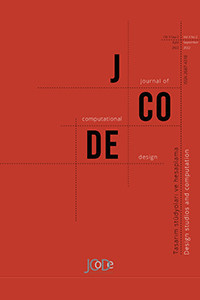A Spatial Grammar Model for Designing Mass Customized High-rise Housing Blocks
Emergence as a product of natural processes is a typical feature for traditional and vernacular housing settlements created by different users with their various needs. However, this feature disappears in housing production approaches for uniform and standard users due to mass production concerns. The main reason is that user needs cannot be fully transferred to design strategies due to excessive standardization. One of the main factors in this is the need for design tools and methods that effectively evaluate preferences with complex relationships. Shape grammars and spatial grammars, one of the generative design approaches, exhibit original emergence examples with their rich diversity and adaptability to different approaches. Hence, it can be seen as an alternative for solving such problems. This article presents a parametric spatial grammar model that can design high rise housing blocks with customized dwelling for each family. The compositions of these houses ground on specific spatial relationships defined by parametric rule sets. In the article, the generative design process was developed in two stages. The first stage includes the formal, syntactical, and functional relations of the spaces in a floor plan, their representation according to the rules, and generating alternative solutions. The second stage consists of the representation of the facade rules and the parametric grammar that generates the facades. In the developed spatial grammar model, user preferences are transferred to the computer through the designed interface. Dimensional properties of housing blocks are defined by a gridal system, which is determined according to user preferences and used as a starting base for spatial grammar. Plan layouts are generated on this defined grid and by sequential application of rules. In conclusion, the adaptability of spatial grammar and the rich alternatives designers can use and develop are emphasized.
Anahtar Kelimeler:
Emergence, Spatial Grammar, Mass Customization, Housing Design, Generative design
___
- Agarwal, M., & Cagan,J. (2000). On the use of shape grammars as expert systems for geometry-based engineering design. Artificial Intelligence for Engineering Design, Analysis and Manufacturing: AIEDAM, 14(5). https://doi.org/10.1017/S089006040014507X
- Çaǧdaş, G. (1996). A shape grammar: The language of traditional Turkish houses. Environment and Planning B: Planning and Design, 23(4), 443–464. https://doi.org/10.1068/b230443
- Coyne, R. (1989). Logic Models of Design. Pitman.
- Downing, F., & Flemming, U. (1981). The Bungalows of Buffalo. Environment and Planning B: Planning and Design, 8(3). https://doi.org/10.1068/b080269
- Duarte, J. P. (2005). Towards the mass customization of housing: The grammar Siza's houses at Malagueira. Environment and Planning B: Planning and Design, 32(3). https://doi.org/10.1068/b31124
- Flemming, U. (1981). The secret of the Casa Giuliani Frigerio. Environment and Planning B: Planning and Design, 8(1). https://doi.org/10.1068/b080087
- Godoi, G. De, & Celani, G. (2006). A study about facades from historical brazilian town using shape grammar. Proceedings of Sigradi 2008.
- Granadeiro, V., Duarte, J. P., Correia, J. R., & Leal, V. M. S. (2013). Building envelope shape design in early stages of the design process: Integrating architectural design systems and energy simulation. Automation in Construction, 32. https://doi.org/10.1016/j.autcon.2012.12.003
- Grasl, T. (2012). Transformational Palladians. Environment and Planning B: Planning and Design, 39(1). https://doi.org/10.1068/b37059
- Hoisl, F., R. (2012). Visual, Interactive 3D spatial grammars in CAD for computational design synthesis. Technische Universität München.
- Hoisl, F., & Shea, K. (2011). Interactive, visual 3D spatial grammars. In S. Gero, J. (Ed.), Design Computing and Cognition '10 (pp. 643–662). Springer. https://doi.org/10.1007/978-94-007-0510-4_34
- Knight, T. (2003). Computing with emergence. Environment and Planning B: Planning and Design, 30(1), 125–155. https://doi.org/10.1068/b12914
- Koning, H., & Eizenberg, J. (1981). The Language of the Prairie: Frank Lloyd Wright's Prairie Houses. Environment and Planning B: Planning and Design, 8(3). https://doi.org/10.1068/b080295
- McKay, A., Chase, S., Shea, K., & Chau, H. H. (2012). Spatial grammar implementation: From theory to useable software. Artificial Intelligence for Engineering Design, Analysis and Manufacturing: AIEDAM, 26(2), p143–159. https://doi.org/10.1017/S0890060412000042
- Stiny, G. (1980a). Introduction to shape and shape grammars. Environment and Planning B: Planning and Design, 7, 343–351. https://doi.org/10.1068/b070343
- Stiny, G. (1980b). Kindergarten grammars: designing with Froebel's building gifts. Environment and Planning B: Planning and Design, 7(4), 409–462. https://doi.org/10.1068/b070409
- Stiny, G. (1982). Shapes are individuals. Environment and Planning B: Planning and Design, 9(3), 359–367. https://doi.org/10.1068/b090359
- Stiny, G., & March, L. (1981). Design machines. Environment and Planning B, 8, 245–255.
- Stiny, G., & Mitchell, W. J. (1978). The Palladian grammar. Environment and Planning B: Planning and Design, 5(1), 5–18. https://doi.org/10.1068/b050005
- Strobbe, T., Eloy, S., Pauwels, P., Verstraeten, R., De Meyer, R., & Van Campenhout, J. (2016). A graph-theoretic implementation of the Rabo-de-Bacalhau transformation grammar. Artificial Intelligence for Engineering Design, Analysis and Manufacturing: AIEDAM, 30(2). https://doi.org/10.1017/S089006041600003
- Yayın Aralığı: Yılda 2 Sayı
- Başlangıç: 2019
- Yayıncı: İstanbul Teknik Üniversitesi
Sayıdaki Diğer Makaleler
A Spatial Grammar Model for Designing Mass Customized High-rise Housing Blocks
Ahmet Emre DİNÇER, Gülen ÇAĞDAŞ
Paylaşımlı E-Scooter Yerleştirmeye Yönelik Bir Karar Destek Sistemi: İstanbul İçin Vaka Çalışması
Begüm MORALIOĞLU, Şehnaz CENANİ, Gülen ÇAĞDAŞ
Müzik Verilerini Kullanan İnteraktif Duvar Tasarımı
Etmen-tabanlı modellemede belirme ve karmaşıklık: Güncel araştırmaların incelenmesi
Origami ve Hücresel Özdevinim Entegrasyonu ile Kabuk Tasarımı
